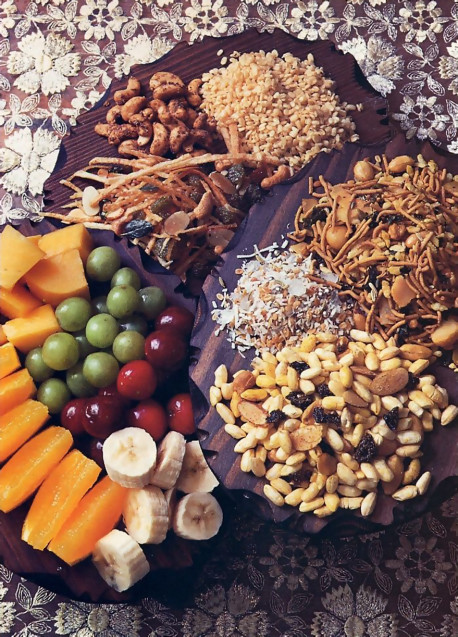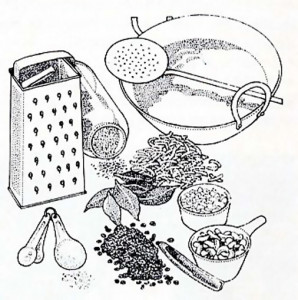A Taste of Vedic Hospitality
With spiritual vision and a variety of these tasty snacks,
you can make any guest feel welcome.
by Visakha-devi dasi
In every culture, there’s an etiquette for receiving guests, but probably nowhere was this etiquette more developed than in the Vedic culture that flourished in India fifty centuries ago. An important part of Vedic reception was the cuisine, which featured a variety of delectable dishes. This month, we offer you a glimpse into this tradition of hospitality as well as some classic Vedic recipes that you can prepare for your next guest.
The Vedic tradition trained householders to see all living beings as part and parcel of the Supreme Lord, Krsna. Thus, Vedic householders felt themselves responsible for giving shelter and comfort not only to their immediate family but to Krsna’s family—everyone. The Vedic injunction is that even if an enemy comes to your home, you should receive him so well he doesn’t apprehend any danger. In fact, even a snake in your home should not go hungry! This training helped the householder become broad-minded, seeing every living being in relation to Lord Krsna.
The Vedic system enjoins that we receive a guest according to our means; if we’re so poor that we cannot offer food, we can still satisfy a guest with a comfortable sitting place, fresh water, and pleasant words of welcome. If we’re well-off, we can offer a lavish feast.
When Lord Krsna was present on earth, He personally showed the example of hospitality. The Srimad-Bhagavatam relates how Lord Krsna welcomed His devotee Akrura:
Lord Krsna, who is very kind to His devotees, embraced Akrura. Taking him by the hand, Krsna brought him to His sitting room, where He offered him a very nice sitting place and water for washing his feet. He also worshiped him with suitable presentations of honey and other ingredients. When Akrura was thus comfortably seated, Krsna brought very palatable dishes, and Akrura accepted them. When Akrura finished eating, the Lord gave him spices as well as pulp of sandalwood, just to make him more pleased and comfortable. The Vedic system of receiving a guest was thus completely observed by Lord Krsna.
Although the India of Vedic days has gradually disappeared, a vestige of Vedic hospitality remains, and it was demonstrated in 1970 when Srila Prabhupada toured India with twenty-five of his American and European disciples. These Western devotees, who for several years had tolerated the quizzical and sometimes hostile attitudes of their countrymen, got an unexpected taste of traditional Vedic hospitality. In Surat, for example, a city in Gujarat state on the west coast of India, crowds gathered to garland Srila Prabhupada and his disciples when they chanted through the streets. Each day a different family would invite the group to their home. The Western disciples would have kirtana, Srila Prabhupada would speak about Krsna consciousness, and then the hosts would serve a sumptuous feast of Krsna prasadam.
Similarly, in Calcutta, Indore, Bombay, Gorakhpur, Madras, Delhi—everywhere the Western devotees went—they were well received.
According to the Vedic tradition, the host is greatly benefited by receiving saintly persons. The genuine saint does not go to someone’s home to fill his empty stomach; nor does he go to complain, socialize, or gossip. A saintly person goes to a home to instruct the people there in spiritual life. And certainly this was why Srila Prabhupada traveled with his disciples throughout India—just to remind Indians of their great spiritual heritage. The householders who welcome such visitors are benefited, and their home is sanctified. However, that home where saintly guests are not admitted or respected is condemned, for its residents are unaware of the higher values of life. All of us should consider it a sacred duty and privilege to welcome guests, especially saintly guests.
If the company is expected, there’s usually time to make piping hot savories, tantalizing sweetmeats, or an entire meal. But, for the unexpected guest, here are some nibblers you can prepare and keep on hand to serve between meals. These are deep-fried and salty foods that have a diverse range of textures and flavors. You can store them in air-tight jars and eat them at room temperature, or warm them in the oven. Serve them with a cool drink, fresh cut fruit, or a sweet. They’re ideal for offering to Lord Krsna—and then to your guest.
(Recipes by Yamuna-devi dasi)
Crispy Deep-Fried Dal
(Dalmut)
Yield: 2 cups
Soaking time: 12-24 hours
1 cup split chana dal or moong dal
½ teaspoon fine popcorn salt or equivalent fine sea salt
1 tablespoon baking soda
2 ½ cups ghee (clarified butter) or vegetable oil for deep frying
1. Sort through the dry dal beans and remove any foreign matter. Place the beans in a strainer and lower it into a large bowl of fresh water. Rub the grains between your palms. Change the water and repeat the washing 3 or 4 times or until the water is practically clear.
2. Fill a 1-quart bowl half full of cool water, add the dal and baking soda, stir, loosely cover, and soak in a cool place for 12 hours. (If moong dal is used. soak for 6 to 8 hours.)
3. Drain and rinse the dal. Soak for an additional 12 hours (6 to 8 hours for moong dal) in clean, fresh, cool water.
4. Drain and spread the dal out on a wire screen or clean absorbent towel to dry for 2 to 3 hours. (Insufficient drying may result in an overly-crunchy finished product.)
5. Heat the ghee or oil in a suitable deep-frying vessel over a medium flame to about 375°F. Sprinkle in 1/3 cup of the dal beans. They will sink to the bottom of the pan, and the hot oil or ghee will froth up the sides of the pan. After 2 to 3 minutes the frothing will subside, and the dal will float to the surface. The frying is completed when the dal is crispy and a light golden color. It should not be allowed to brown. Lift out all the dal kernels with a fine-meshed strainer spoon and transfer to absorbent paper. Fry the remaining dal, 1/3 cup at a time.
6. While still warm, sprinkle with fine-textured salt and toss to mix. When the dal is cooled to room temperature, it may be stored in a well-sealed jar. Fried dal will remain fresh for up to 3 weeks. After that, it gets stale. Refresh dry dal by warming it in a preheated 250° oven for 5 to 7 minutes.
Deep-Fried Potato Straws, Cashews, Raisins, and Coconut
One afternoon in Indore, India, in the winter of 1970, His Divine Grace A.C. Bhaktivedanta Swami Prabhupada was receiving offerings from a large gathering of villagers. This preparation was brought fresh and warm in a clean woven basket, along with a large basket of fresh green coconuts. All present thoroughly relished the refreshment, and Srila Prabhupada commented on how expertly it was assembled. He noted that this chidwa was one of his spiritual master’s favorite afternoon refreshments. Here is that memorable specialty.
Yield: 10 servings
12 ounces baking potatoes (about two medium-sized potatoes)
3 cups ghee or vegetable or nut oil
3 fresh hot green chilis, halved, seeded, and sliced lengthwise into paper-thin strips
1 teaspoon cumin powder
¼ teaspoon cayenne or chili powder
½ teaspoon turmeric powder
1 teaspoon garam masala
1 teaspoon salt
1 tablespoon sugar or powdered rock candy
1 ½ tablespoons ghee or oil
½ cup raw cashew nuts (coarse bits or halved)
1 tablespoon fennel seeds
2 tablespoons sesame seeds
10 to 15 fresh or dried small sweet neem leaves
½ cup raisins or currants
½ cup dried ribbon-type coconut
1. Wash and peel the potatoes. Hold a potato lengthwise in your hand, place it at a slight angle on a hand shredder, and shred through the large holes to yield long, thin straws. Place the potato straws in a colander, rinse thoroughly under cold, running tap water, then soak in cold water for ten minutes. Shake the colander to drain off all of the excess water; thoroughly pat the potatoes dry between absorbent towels.
2. Over a high flame, heat the clarified butter or oil in a deep-walled frying pan or wok until the temperature reaches about 375 °F. Drop in a small handful of potato straws and fry for about 2 minutes or until they are crisp and golden brown; remove with slotted spoon and drain on absorbent paper. When all of the potato straws are fried, drop in the green chilis and fry until they blister and turn golden brown; remove with a slotted spoon and transfer to absorbent paper to drain.
3. Blend the powdered spices, salt, and sugar in a small bowl. Heat 1 ½ tablespoons of ghee or oil in a 7-inch frying pan over medium-low heat for about 1 ½ minutes. Add the cashews and fennel seeds; stir-fry for about 5 minutes. Drop in the sesame seeds and sweet neem leaves and continue to stir-fry the mixture until the nuts are golden brown; remove the pan from the heat and pour contents through a fine-meshed strainer resting over a bowl. Save the excess ghee or oil for further use.
4. Combine all of the ingredients in a large mixing bowl and gently toss to mix well. Serve fresh and warm or cool to room temperature; store in a well-sealed container at room temperature for up to 2 weeks.
Srila Prabhupada’s Puffed Rice and Nuts
(Mourri-Kishmish-Kaju Chidwa)
His Divine Grace A.C. Bhaktivedanta Swami Prabhupada gave his disciples the recipe for this simple snack in Indore, India, in 1970.
Yield: 6 servings
¼ cup ghee or vegetable oil
1/3 cup cashew nuts, halved or broken
1/3 cup shelled peanuts, halved or whole
1 fresh hot green chili, seeded and pureed or minced fine
1 teaspoon peeled fresh ginger root, minced fine
¼ cup raisins or currants
½ teaspoon turmeric powder
2 teaspoons coriander powder
¼ teaspoon mild asafetida powder
1 teaspoon fine popcorn salt or regular salt
1 2/3 cups puffed rice
2 teaspoons granulated sugar or powdered rock candy
1. Heat 2 tablespoons ghee or oil in a 7-inch frying pan over a medium-low flame. Slowly fry cashews for about 7 to 10 minutes until golden brown. Remove with a slotted spoon and drain on absorbent paper. Prepare the raw peanuts in the same way.
2. Blend the powdered spices and salt in a small bowl.
3. Heat the remaining 2 tablespoons of ghee or oil in a 3- to 4-quart saucepan over a medium flame until a drop of water flicked in instantly sputters. Add the minced ginger and chilis and fry until browned; toss in the raisins, nuts, powdered spices, and salt. Immediately follow by pouring in the puffed rice. Stir-fry for 3 to 4 minutes, mixing the seasonings throughout the puffed rice.
4. Add the sugar and the ghee or oil remaining from the nuts. Toss and fry for a few more seconds. Offer to Krsna and serve fresh and hot.



Leave a Reply